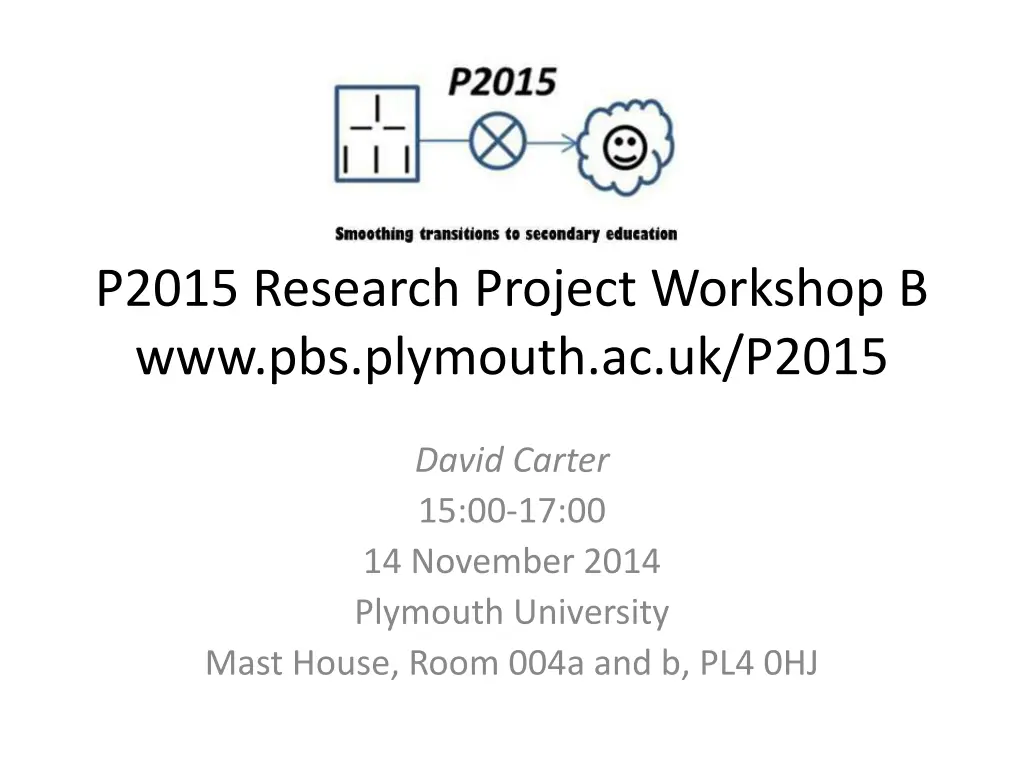
P2015 Research Project Workshop at Plymouth University
Join the P2015 Research Project Workshop at Plymouth University to explore the impact of competing for secondary school places on children. The workshop aims to quantify the problem through testing interventions, collecting diverse views, and assessing progress. Participants will engage in group model building, introductions to the project problem, and discussions on hopes and fears related to the workshop outcomes.
Download Presentation

Please find below an Image/Link to download the presentation.
The content on the website is provided AS IS for your information and personal use only. It may not be sold, licensed, or shared on other websites without obtaining consent from the author. If you encounter any issues during the download, it is possible that the publisher has removed the file from their server.
You are allowed to download the files provided on this website for personal or commercial use, subject to the condition that they are used lawfully. All files are the property of their respective owners.
The content on the website is provided AS IS for your information and personal use only. It may not be sold, licensed, or shared on other websites without obtaining consent from the author.
E N D
Presentation Transcript
P2015 Research Project Workshop B www.pbs.plymouth.ac.uk/P2015 David Carter 15:00-17:00 14 November 2014 Plymouth University Mast House, Room 004a and b, PL4 0HJ
Purpose of todays P2015 Workshop Support aim of explaining impact of competing for secondary places on children with objective of quantifying the problem with applicable agents by:- Testing intervention opportunities; Collating views on problem linkages; Assessing progress and improvements with methods.
Agenda Group Model Building Introductions and problem 15:00 (slide) Nominal Group Technique 15:10 (paper forms) Causal Model Map 15:50 (whiteboard) Debriefing Survey 16:45 (clicker responses) Parking and refreshments available
Introductions & Project Problem Primary schools currently experiencing population bulge but 17% more children a year putting pressure on 95% first choice Plymouth secondary school expectations not yet a major concern for multi-agent modellers from council, health and education; Parents and children relationship when deciding secondary school of greater value to participants; How might parents and children select schools best matched to their needs in an uncertain future?
Recap Hopes and Fears from Workshop A Modeller Hope Fear 1 Genuine multi-agency working Time commitment too high 2 Systemic perspective Negative impact on individuals 3 Meaningful change for family/child Reductionist perspective 4 Positive support for explaining available choices Not broad enough group 5 Practical change benefits Whether it will make a difference
Nominal Group Technique for potential applicant wellbeing policy interventions Policy A Policy B Policy C Originator 1 10 mins Reviewer 2 5 m Reviewer 3 5 m Reviewer 4 5 m Review update 5 m Best policy Y/N Y/N Y/N accepted preferred school pace accepted on appeal pace grammar school pre acceptance pace initial grammar entrance failed appeal against preference result pace preference entry pace APPLICANT ADMISSIONS preference applicants appeal applicants competitive entry pace competitive applicants examinations pace rejected on appeal pace leave state secondary education pace depart state secondary education pace exit state secondary education pace appeal against competitive result
Sketching a Causally Mapped Model Cause + Balanced Loop Control Example; more smoke more disease, more diseased fewer smoke. e.g. smoke - Effect e.g. disease
In-year admission dynamics example LEVERS degree of competetion STRUCTURE proportion 1st preference offers applicants option choosing accepting expressed anxiety state student wellbeing reducing RESPONSE
Electronic methods debrief; use clicker Question 4 Question 3 agree part agree Question 2 disagree Question 1 0 1 2 3 4 5 6
